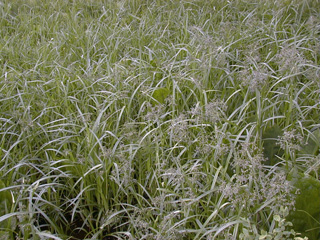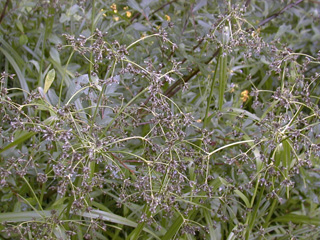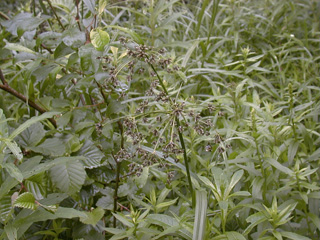


General Species Description
- A very common, large, robust, perennial species. Grows up to 170 cm tall. This species is leafy, dark green, with stout, slightly triangular stems. The leaves spread out in a three ranked arrangement from the stem. The stems are coarse and arise from stout, well-developed creeping rhizomes either singularly or in a dense basal clump.
Leaves
- Yellow-green, sharp, serrated margined, cuts easily, 10-15 mm wide, with a deep central vein. Leaves are grass like and have pointed tips. Leaf sheaths are purple-tinged with white cross walls. Generally extend beyond the flower heads.
Inflorescence/Flowers
- Small clusters of sessile spikelets. The spikelets are 3-8 mm long, and more than 50. Some spikelets can be found on the stem, some on the stalks. Diffuse. The many involucral bracts are unequal and leaf-like. Scirpus microcarpus blooms from June through August.
Fruits
- Very small, pale, oval achenes. Achenes have pointed tips. Surrounding the achene are 4-6 bristles sub-equal to the achene. Scales are green with a black midstripe extending past the tip as a short awn.
Habitat
- Scirpus microcarpus grows well in saturated to inundated nitrogen rich soils. Grows well in disturbed areas, in mud, in wooded wetlands, mucky areas adjacent to streams, and in standing spring water or swamps. Shade intolerant. Low to mid elevations.
Range
- Found within many wetlands throughout the Pacific Northwest, throughout western North America, and in Asia. Scirpus microcarpus is generally associated with Lysichiton americanum (skunk cabbage), Juncus effusus (soft rush), Salix scouleriana (Scouler willow), and Salix sitchenis (Sitka willow).
Similar Species
- Scripus atrocinctus (Woolly Sedge), Carex obnupta (Slough Sedge) when not in flower
Ecological Value
- Used by wildlife for food and nesting material. Muskrat eat the seeds, swans and geese eat the shoots, and geese eat the rhizomes and leaves.
Human Value
- Native Americans used the plant for trim on hide clothing and for weaving light duty baskets.
References
- Pojar, J. and MacKinnon, A., Plants of the Pacific Northwest Coast, 1994. Cooke, S.S., A Field Guide to the Common Wetland Plants of Western Washington and Northwestern Oregon, 1997. Guard, B. J., Wetland Plants of Oregon and Washington, 1995.
This page was created by: Michelle Michaud, August 1999
Return to Northwest Oregon
Wetland Plants Project